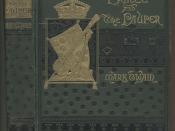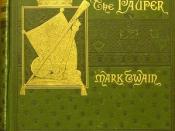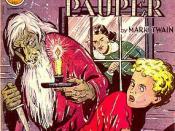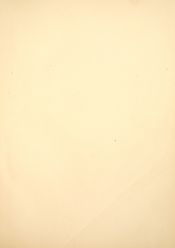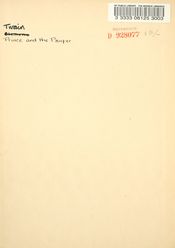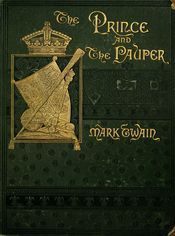The Prince and the Pauper This tale documents how a twist of fate can alter one's life. It begins with Edward Tudor (Prince, by birth) and Tom Canty (Pauper) switching clothes one day and, in turn, accidentally switching lives. The Prince must now endure the slums of the country in which his father rules. He is beaten, starved, and must beg for food. This aspect of the tale would have given others and me some satisfaction if the Prince proved to be a spoilt brat (routing for the underdog). However, the Prince is kind from the very beginning when he invites Tom into the palace after being mistreated by a guard. Thus, the reader is thoroughly frustrated at the misfortune Edward must endure. Tom, however, lives in the palace and is trying to cope with the ceremonies and traditions required by the Prince of Wales. His seemingly odd behavior is classified as insanity by Henry, the King, and the Lords and Nobles.
He slowly but surely adjusts, however, and upon succeeding Henry, turns out to be a very wise king. At the same time, Edward persistently claims to be the rightful king, to all he encounters. For this, he is thoroughly mocked and beaten all the time. Miles Hendon, a man who saves him many different times, befriends him.
The "true" Prince spends a short amount of time in jail in which he must witness as innocent people have limbs cut off, and are burned at the stake. He remembers it all though, and promises himself when he is returned to his rightful position he will rule mercifully and correct unjust laws. Due to his persistent claim that he is king, he is sentenced to twelve lashings in which Miles takes for him. Edward is greatly moved that he could be so generous. It is within; these prison walls, in my opinion, that Twain uses the most intense satire throughout the book, socially criticizing the unjust laws and practices of the time period.
They are eventually released and head towards London where the Coronation Ceremony is underway. Tom, of course, is the main attraction, with thousands cheering and hailing him as the new king that will bring glory to England. Twain elaborately describes the ceremony, bursting with cheers and jewels, blaring trumpets, and royal processions. Tom is indeed glowing with excitement to be hailed as The King of England. He moves toward the throne whilst all of England holds it breath as the Archbishop of Canterbury lifts the crown, preparing to lay it upon the mock king's head. Twain writes, "At this impressive moment, a startling apparition intruded upon the scene---an apparition observed by none in the absorbed multitude, until it suddenly appeared, moving up the great central aisle. It was a boy, bare headed, ill shod, and clothed in course plebeian garments that were falling to rags. He raised his hand with a solemnity which ill comported with his soiled and sorry aspect, and delivered this note of warning: "I forbid you to set the crown of England upon that forfeited head. I am the king!" Having read this tale and subsequently sought out other reviews, I find myself concurring With the eloquently stated critique authored by Zack Hamilton: "There were no sub-theses in The Prince and The Pauper. In The Prince and The Pauper there were a few questions that were left unanswered. How did Tom Canty's family look at Tom when he came back into the lifestyle he had before his experience? The same thing with Prince (now king) Edward VI and his family. How did each of their families feel about what happened? How did the families react when they found out about the experience? These were just a few of the questions that the book left unanswered.
The seven points of critical analysis are chapters, footnotes, realism, pictures and maps, introduction, index, and author. This part will explain each of these and their relation in The Prince and The Pauper. The first point is chapters, the chapters in The Prince and The Pauper are arranged rather well. The chapters are a whole other part of the book. In the first chapter (page 1) the book talks about the births of the prince and the pauper. In the second chapter the book talks about Tom Canty's home lifestyle (page3). The second point of critical analysis is footnotes. Not all books have footnotes, but I sure am glad this one did. Take for example page 70 it mentions "the loving-cup", I have no idea what it means so I looked it up in the back and there it was note number four, page seventy, "The Loving-Cup" plain as day. The third point of critical analysis is realism. The Prince and the Pauper is not very real, even for the time when Mark Twain wrote this book. Would a prince really let a pauper into the royal castle? Even if he did do you think that they would change clothes to see what each other's clothes were like. Don't you think someone would have been there watching the prince and the pauper the whole time that the prince was there. What if the pauper had tried to kill the prince because he was jealous of all the things the prince had compared to everything he had? After a while and nobody had heard from the prince someone would have gone and checked up on him to see if he was all right. The fourth point of critical analysis is the maps and pictures. There were no maps in The Prince and The Pauper. It would have been helpful so that you could tell where everything was and where all the roads were in relation to the Palace, Offal Court, and London Bridge. If they would have had a map it might have helped to find out where all the places in the book were. The pictures in the book were very well done (pages 16, 60, 104, 148, 194, 252, and 262). They helped to explain what the characters looked like at different times in the book. The pictures also helped to show the facial expressions of each character at certain times in the book. The fifth point of critical analysis is the introduction. This book has one but it is hard to understand. The language is very old, and the document date back to who knows when, another thing is it uses words so big you have to have a dictionary right next to you the whole time because you won't understand every other word. The introduction in books is supposed to tell a little bit about the book but all this one does is talk about all other kinds of stuff. The sixth point of critical analysis is index. This book does not have an index; it would have been helpful though. There were a lot of words and phrases that were kind of hard to decipher. One word or phrase in particular was 'you'll swing for this'. It was kind of figure this out for a while but it means the same thing as 'you'll hang for this' it means that they'll string you up and wait for you to die. The seventh point of critical analysis is the author. The author talked a lot about Tom Canty when he should have talked about the Prince Edward just as much, but he didn't. The author also put in a lot of descriptions about people, places, things and whatever else he thought he could describe. All of that describing made the book rather boring and not very gripping. It was like pulling teeth to reading that book. The author also should have talked more about the people around Tom Canty and Prince Edward. He didn't though, that was another thing that made the book boring.
The Prince and The Pauper was a very boring book. This book was chosen because it had some very good reviews. The book was very boring and not very gripping. The book was explained too much. There were too many descriptions about everyone and everything. What kept The Prince and The Pauper boring instead of interesting? Another thing was how the book was how in the beginning of the book they stuck a lot around Tom Canty instead of switching back and forth between him and the Prince Edward. Other than those two distastes the book was OK but not any higher. This book should not be recommend this book to anyone my age because they would enjoy a book with lots of descriptions about everyone and everything." This book critique has expressed what the book was about, it has mentioned seven points of critical analysis, there was a thesis statement, and an opinion of the book, The Prince and The Pauper. As previously stated, I reader did not find reading the book an enjoyable experience, and would not recommend this book to anyone else. It was (predictable and tedious) like pulling teeth. Final note, "DON'T READ THIS BOOK" - "WASTE OF TIME" this is my Advisory.
